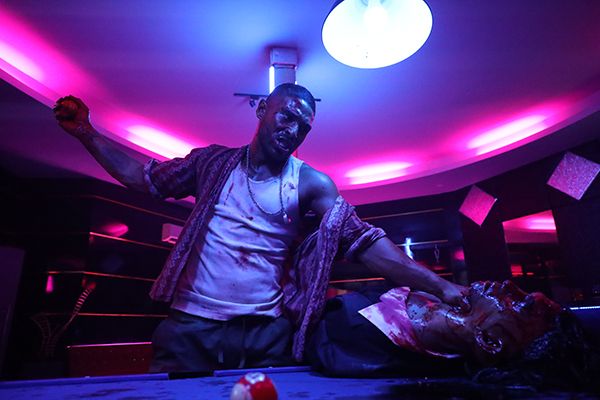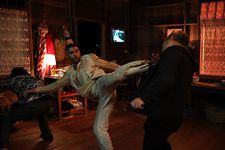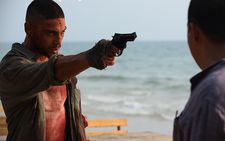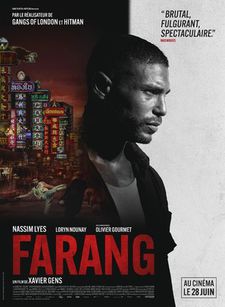 |
| Farang! Photo: courtesy of Frightfest |
A filmmaker who has never been afraid to explore the subject of violence, since his début feature, Frontière(s), in which a group of criminals seeks refuge in an inn run by a group of neo-Nazis, Xavier Gens returns with his revenge thriller Farang (Mayhem!).
The story centres on Sam (Nassim Lyes), who flees to Thailand after being involved in a fatal altercation. There he sets up home with Mia (Loryn Nounay) and her daughter. Their seemingly tranquil life is disrupted when Sam makes a fateful choice, thrusting him and his family into what seems to be an inescapable cycle of destructive violence.
Following the film's international première at Fantasia, Gens spoke with Eye For Film about the influence of the late William Friedkin and the importance of emotion driving the action.
 |
| Farang Photo: Courtesy of IFC Films. |
Paul Risker: Why film as a means of creative expression? Was there an inspirational or defining moment?
Xavier Gens: For me, filmmaking is a way to express love and share an experience with an audience. When I started working on Farang, I wanted to invite the audience to travel.
I became a dad nine years ago, and I had that feeling of what would happen to me if I lost my daughter somewhere? I put that stress and energy into this film, to express that feeling of a dad losing his daughter in a foreign country, who is doing everything he can to find her.
At the same time, it's always about sharing the love I have for cinema. It was also a way to create a new experience in France as a filmmaker. Like the character of Sam, I was like, 'Okay, I need a second chance to express myself in a French genre movie.’ I did it with Frontière(s), and I wanted to explore the genre again in France, and so it was going back to my roots.
PR: To pick up on your point about returning to your earlier career, did this return you to past inspiration, or did something new inspire Farang?
XG: The first inspiration was the second chance theme and the exploration of a foreign country. If I have to compare it to another movie that influenced it, I’d say it was William Friedkin’s Sorcerer, which I consider a masterpiece.
[…] If you look at Farang, the construction of the film is similar to Sorcerer. We have an opening where we establish a character and then there's a transition when we arrive in Thailand. The inspiration for that transition was the way Friedkin starts the transition in Sorcerer, of the characters and the way he shows the village waking in the morning.
Another influence is of course Park Chan-wook’s Oldboy.
PR: On the subject of Friedkin, was it only Sorcerer that inspired Farang, or did he have a broader influence?
 |
| Farang! Photo: courtesy of Frightfest |
XG: Friedkin started out doing documentaries, and in his biography he talked about how a documentary he made [The People vs. Paul Crump] helped save the life of a man on death row. Art in a way saved a life, and reading his book, I remember being super proud of this.
The inspiration to tell stories came from that [real life], and in his book he explained an influence on The French Connection was the police asking silly questions in their interrogations. I realised he was shooting his movies like a documentary, and that's why they're rooted in reality as much as they are - that's why The Exorcist is so scary.
With Farang, I wanted to feel the reality of the story, so that's why I wanted to start the film in prison, with prisoners and immigrants. It’s a continuity of Italian neorealism, and one of the inspirations as well was Stromboli by [Roberto] Rossellini. In the film, [Ingrid] Bergman goes to the immigration office and she has to explain who she is. Rossellini was always taking people from real life and having them interact with actors, and the immigration scenes in Stromboli was the inspiration when Sam and Mia go to the land registry office to buy a plot of land for their restaurant.
I know Friedkin was a fan of Italian neorealism and by being a fan of his films and reading his book, I started to watch more Italian neorealism. This helped me to figure out how to tell the story in Farang. By being strongly influenced by Italian neo-realism and documentary, it broke [the model of] that genre and action style movie.
PR: It’s not until the hour mark that the film becomes more of a traditional revenge film. Up until that point, you do the unusual thing of emphasising emotion, by showing restraint and an appreciation for the longevity of emotion over the desensitising limits of violence.
XG: For me it was important to create a balance between emotion and action, and that's why I wanted an action specialist. Jude [Poyer] did a fantastic job designing the action, but the discussion we had with him was how can the action be supported by emotions? It's not like John Wick - action for action's sake.
 |
| Farang! Photo: courtesy of Frightfest |
No, Farang doesn't want action for [the sake of] fun. Violence and action can be narrative and that was important. We created a symphony with the emotion, and with my editor [Riwanon Le Beller], we found a way to strengthen that climactic scene in the elevator Jude designed. We wanted to feel the emotion driving the action and involving you. If you're not emotionally involved, then I don't think the action makes sense.
When you watch the film, there is only 12 minutes of action, no more. We don't need more, because it's the emotion taking the audience by the hand and telling them where they should focus their attention. I want it to work this way and the film is an experimentation with that process – I’ll pursue this in my next feature.
PR: The violence and action evolve throughout the film, and the elevator scene is an example of a shift in style. In the final showdown, you subvert audience expectations by again emphasising the story’s emotional drama.
XG: That was the intention – take the typical revenge movie and explore the story we all know by heart. It has that structure of a Taken movie, but let's ask what Rossellini or Friedkin would have done with a revenge movie? That was the direction I wanted to explore, and it's really a love letter to cinema, or the way to express and to explore a genre with new elements. It’s a new way to tell the same story we all know and that was something I wanted to experience.
PR: Much of this film is about being trapped in destructive cycles that in some cases are self-inflicted. Farang’s themes echo Nietzsche’s concept of eternal recurrence, reliving the same experiences.
 |
| Farang poster |
XG: I love the idea of the cycle and we talk in Farang about the cycle of violence. The character of Sam kills someone at the beginning of the film, and we don't know if the violence will end.
I wanted to create something meaningful regarding the cycle of violence, because one of the themes is what's the meaning of the cycle? Sam can be saved only by love, which is the opposite of violence. What we’re expressing in this film is he tried to escape violence by finding love, but when he found love, the violence returned. You can see the evolution of the colour palette going from grey to cold colours, to very warm colours as a way to try to express that.
One of the main intentions was to start out as a typical social French movie because of my roots. Then violence starts to intrude, and the typical social French movie evolves into something else, becoming more baroque. Don't forget, this is not an object, it's a movie, and a movie can be different things. Just because we are French doesn’t mean we have to honour the French form all the time. I wanted to mutate the film into something baroque, and the intrusion on that societal stage should work, because movies are international.
Farang (Mayhem!) had its international première at the Fantasia International Film Festival in Montreal.





















